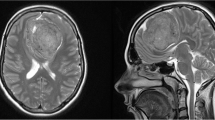Abstract
Recombinant human growth hormone has recently been used to treat the short stature of Turner syndrome. However, this therapy may induce slipped capital femoral epiphysis, since the epiphyseal plate widens and becomes weak through either growth hormone or hypogonadism. This report shows that a slipped capital femoral epiphysis occurred during this treatment for an 11-year-old girl who was suffering from Turner syndrome. Thus, these patients who are being treated with growth hormone should be carefully observed.
Similar content being viewed by others
References
Fidler MW, Brook CGD (1974) Slipped upper femoral epiphysis following treatment with human growth hormone. J Bone Joint Surg [Am] 56:1719–1722
Harris WR (1950) The endocrine basis for slipping of the upper femoral epiphysis. J Bone Joint Surg [Br] 32:5–11
Oka M, Miki T, Hama H, Yamamuro T (1979) The mechanical strength of the growth plate under the influence of sex hormones. Clin Orthop 145:264–272
Prasad V, Greig F, Bastian W, Castells S, Juan C, AvRuskin TW (1990) Slipped capital femoral epiphysis during treatment with recombinant growth hormone for isolated, partial growth hormone deficiency. J Pediatr 116:397–399
Rappaport EB, Fife D (1985) Slipped capital femoral epiphysis in growth hormone-deficient patients. Am J Dis Child 139:396–399
Rennie W, Mitchell N (1974) Slipped femoral capital epiphysis occurring during growth hormone therapy. J Bone Joint Surg [Br] 56:703–705
Rosenfeld RG, Hintz RL, Johanson AJ et al (1986) Methionyl human growth hormone and Oxandrolone in Turner syndrome: preliminary results of a prospective randomized trial. J Pediatr 109:936–943
Rosenfeld RG, Hintz RL, Johanson AJ et al (1987) Results from the first 2 years of a clinical trial with recombinant DNAderived human growth hormone (Somatrem) in Turner's syndrome. Acta Pediatr Scand 331:59–66
Shizume K (1984) Long term effects of human growth hormone on 1959 patients with pituitary dwarfism throughout Japan. Endocrinol Jpn 31:201–206
Takano K, Hizuka N, Shizume K (1986) Treatment of Turner's syndrome with methionyl human growth hormone for six months. Acta Endocrinol 112:130–137
Author information
Authors and Affiliations
Rights and permissions
About this article
Cite this article
Sakano, S., Yoshihashi, Y. & Miura, T. Slipped capital femoral epiphysis during treatment with recombinant human growth hormone for Turner syndrome. Arch Orthop Trauma Surg 114, 237–238 (1995). https://doi.org/10.1007/BF00444271
Received:
Issue Date:
DOI: https://doi.org/10.1007/BF00444271




